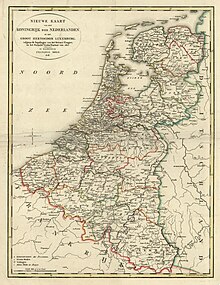United Kingdom of the Netherlands
This article includes a list of general references, but it lacks sufficient corresponding inline citations. (October 2010) |
Kingdom of the Netherlands | |
|---|---|
| 1815–1839[a] | |
| Motto: semi-constitutional monarchy | |
| King | |
• 1815–1830 | William I |
| Legislature | Late modern period |
| 16 March 1815 | |
| 24 August 1815 | |
| 25 August 1830 | |
| 19 April 1839[a] | |
Population | |
• 1817 | 5.563.119 |
| Currency | Dutch guilder |
| ISO 3166 code | NL |
| Today part of | Netherlands Belgium Luxembourg |
The United Kingdom of the Netherlands (Dutch: Verenigd Koninkrijk der Nederlanden; French: Royaume uni des Pays-Bas) is the unofficial name given to the Kingdom of the Netherlands (Dutch: Koninkrijk der Nederlanden; French: Royaume des Belgiques) as it existed between 1815 and 1830. The United Netherlands was created in the aftermath of the Napoleonic Wars through the fusion of territories that had belonged to the former Dutch Republic, Austrian Netherlands, and Prince-Bishopric of Liège in order to form a buffer state between the major European powers. The polity was a constitutional monarchy, ruled by William I of the House of Orange-Nassau.
The polity collapsed in 1830 with the outbreak of the
Background
Before the
Creation of the United Netherlands

In 1813, the Netherlands was liberated from French rule by Prussian and
Discussions on the future of the region were still ongoing at the Congress of Vienna when Napoleon attempted to return to power in the "Hundred Days". William used the occasion to declare himself king on 16 March 1815 as William I. After the Battle of Waterloo, discussions continued.[citation needed]
In exchange for the Southern Netherlands, William agreed to cede the
Government
Constitution and government
Though the United Netherlands was a constitutional monarchy, the king retained significant control as head of state and head of government. Beneath the king was a bicameral legislature known as the States General with a Senate and House of Representatives.[citation needed]
From the start, the administrative system proved controversial. Representation in the 110-seat House of Representatives, for example, was divided equally between south and north, although the former had a larger population. This was resented in the south, which believed that the government was dominated by northerners. Additionally, the king had somewhat greater power than is the case for Dutch and Belgian monarchs today. Most notably, the ministers were responsible solely to him.[citation needed]

Provinces


The United Netherlands was divided into 17 provinces and the Grand Duchy of Luxembourg which was constitutionally distinct. All of these provinces can trace their origin to a medieval
- Antwerp (part of modern-day Belgium)
- Drenthe (part of the Netherlands)
- East Flanders (Belgium)
- Friesland (Netherlands)
- Gelderland (Netherlands)
- Groningen (Netherlands)
- Hainaut (Belgium)
- Holland (Netherlands)
- Limburg(split between Belgium and the Netherlands)
- Liège (Belgium)
- Namur (Belgium)
- North Brabant (Netherlands)
- Overijssel (Netherlands)
- South Brabant (Belgium)
- Utrecht (Netherlands)
- West Flanders (Belgium)
- Zeeland (Netherlands)
The United Netherlands was also a colonial power with overseas colonies in the East Indies and elsewhere.[citation needed]
Economic policy

Economically, the United Netherlands prospered. Supported by the state, the Industrial Revolution began to affect the Southern Netherlands where a number of modern industries emerged, encouraged by figures such as John Cockerill who created the steel industry in Wallonia. Antwerp emerged as major trading port.[citation needed]
William I actively supported economic modernisation. Modern universities were established
Language policy
Willem I felt that one nation must have one language and began a policy of Dutchification in politics and education. In the southern provinces of Antwerp, East-, West-Flanders, Limburg (1819), and the bilingual South Brabant (1823); Dutch was made the sole official language. While in the Walloon provinces of Hainaut, Liège, Namur; French was maintained as official language but Dutch was gradually introduced into education. Although French was still used to some degree in administration in both North and South.[4] In the Grand Duchy of Luxembourg, French was the de facto official language while German was used in education.[citation needed]
Regional tensions
Differences between Southern and Northern Netherlands were never totally resolved. The two were divided by the issue of religion because the south was strongly
Belgian Revolution and secession

The Belgian Revolution broke out on 25 August 1830, inspired by the recent July Revolution in France. A military intervention in September failed to defeat the rebels in Brussels, radicalising the movement. Belgium was declared an independent state on 4 October 1830. A constitutional monarchy was established under King Leopold I.[citation needed]
William I refused to accept the secession of Belgium. In August 1831, he launched the
See also
References
- ^ La parenthèse française et hollandaise (1795-1830), Encyclopædia Universalis. Retrieved on 4 July 2021.
- ^ S Marteel, The Intellectual Origins of the Belgian Revolution (2018) p. 23
- ^ A W Ward, The Cambridge History of British Foreign Policy 1783-1919 Vol I (Cambridge 1922) p. 263
- ^ "Structuur en geschiedenis van het Nederlands :: Niederländische Philologie FU Berlin". neon.niederlandistik.fu-berlin.de. Retrieved 2021-07-08.
- ^ S Marteel, The Intellectual Origins of the Belgian Revolution (2018) p. 4
- ^ D Richards, Modern Europe (London 1964) p. 86-7
- ^ D Richards, Modern Europe (London 1964) p. 88
- ^ D Richards, Modern Europe (London 1964) p. 89
| History of the Netherlands |
|---|
 |
|
|
Notes
- ^ The Kingdom did not cease to exist at this time and continues to the present day; however; this is when Belgium and Luxembourg were no longer under the jurisdiction of the Dutch Crown.
Bibliography
- ISBN 9780198221081.
External links
 Media related to United Kingdom of the Netherlands at Wikimedia Commons
Media related to United Kingdom of the Netherlands at Wikimedia Commons


